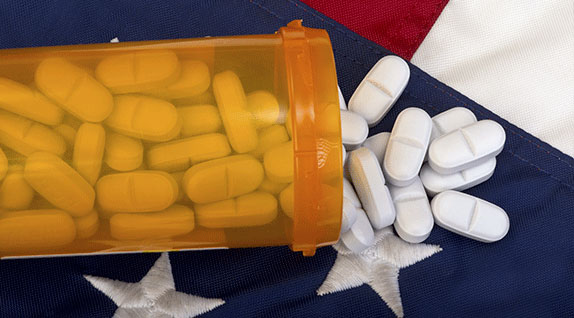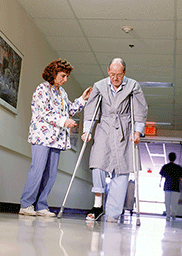 Thinkstock
Thinkstock
Article
United States citizens’ reliance on drug medications continues to grow. Why does good health remain elusive in an affluent country?
Learn the why behind the headlines.
Subscribe to the Real Truth for FREE news and analysis.
Subscribe NowTurn on any television across America and you will likely glimpse one of the 80 of these that air hourly on stations across the nation. Commercials featuring families on fishing trips or prancing through fields, co-workers golfing or discussing the latest news over hearty salads, couples dancing, walking dogs, enjoying romantic candlelight dinners, or side by side in bathtubs overlooking the sunset—even glowing butterflies flitting from person to person to help them sleep.
At first glance, such clips seem to advertise the great outdoors or healthy eating. In reality, though, they showcase what has become a staple of American life: prescription medications.
Behind these happy images, warnings are softly rattled off. One commercial for a self-injection medication for clearer skin ends with an announcer listing side effects far more concerning than the condition itself: “Serious sometimes fatal infections and cancers, including lymphoma, have happened, as have blood, liver and nervous system problems, serious allergic reactions, and new or worsening heart failure…”
Such warnings are often tied to drugs to treat depression, diabetes, arthritis, osteoporosis, erectile dysfunction disorder, high cholesterol, fibromyalgia, and the list goes on.
Despite dire warnings from the drug companies themselves, more than 70 percent of Americans—223 million—take at least one prescription drug. Over 50 percent, about 160 million, take two. This means that only a minority of people in the country do not take pills regularly!
Direct-to-consumer drug commercials are only permitted in the United States and New Zealand. And pharmaceutical companies in the U.S. take full advantage of this ability, with many spending more than $4 billion a year on ads.
To an outsider, Americans must seem to be some of the most diseased people on Earth. The U.S. consumes 75 percent of the world’s prescription drugs even though it makes up only about 5 percent of the world population!
“Of the top 10 advertised drugs, two are for erectile dysfunction…three are for arthritis…two are for mental health issues…and one each is for stroke prevention…fibromyalgia…and diabetes…” The Chicago Tribune reported.
Ironically, while innumerable drugs are available to treat a multitude of conditions, the number of people affected by them continues to climb. In 2015, for example, diabetes hit an all-time high, with almost a full 10 percent of the country now being affected.
The number of Americans who continue to rely on prescription drugs for “good health” is shocking given that the nation is the global leader in healthcare spending. Why, in a Western country with one of the highest GDPs and arguably the broadest access to healthful food, do so many rely on pills to make them well?
What Is Happening
Drugs for a plethora of conditions or desired effects are on the market and available to Americans.
Most prescriptions are for chronic pain and are taken by many of the 116 million citizens who suffer from it. A plentiful list of painkillers can be used to mask the discomfort that almost a full one-third of Americans endure.
The following story reported by AARP portrays this vicious cycle.
 Thinkstock
Thinkstock
“After years of suffering from a degenerative back condition, [one woman] worried that she was already taking too many pills. But when her doctor reassured her that a long-acting opioid medication called OxyContin would fight her pain without any negative repercussions, she decided to try it. At first the pills helped. As their effectiveness diminished, though, she had to take more and more pills to get any relief at all. ‘Within seven months I was taking 280 milligrams a day,’ [she said]. ‘That’s the equivalent of 56 Percocets a day. I was completely addicted.’ When a new doctor balked at refilling her prescription, she discovered what heroin addicts go through when they can’t get a fix. ‘My body was screaming for the drug. My brain was screaming for it.’”
A New York Times article revealed that Americans dominate the global appetite for pain pills, consuming 99 percent of the world’s supply of Vicodin, 80 percent of the oxycodone supply, and 65 percent of the world’s Dilaudid.
This reliance on pain pills has grave consequences. It results in 44 deaths and over 1,300 emergency room visits daily—over 16,000 deaths a year.
Not all prescriptions are for pain. For the 30 million Americans at risk of cardiovascular disease because of high cholesterol, medication is taken as a preventive measure. Data from the Centers for Disease Control and Prevention showed a sharp increase over the last decade in the number of people over age 40 who took cholesterol-lowering medication.
There is also medicine if one just wants a full night’s sleep. Four percent of adults over age 20 use sleep aids, the CDC found. Interestingly, the higher a person’s age and education, the more likely he or she is to use a sleep aid.
Estimates reveal that about 70 million people suffer from sleep disorders or deprivation. This helped drive prescription sleeping aid sales to $1.48 billion in 2013, IMS Health revealed. A great number of those who take such pills use them to adjust between day and night shifts, or to overcome jetlag.
Then there are drugs for the one in five people in America who have been diagnosed with a host of behavioral or mental issues—bipolar disorder, schizophrenia, obsessive-compulsive disorder, depression, aggression, attention deficit disorder, and mood instability. Each year, Americans spend more than $18 billion on antipsychotics, $11 billion on antidepressants, and $7 billion on drugs to treat ADHD.
The American Psychological Association expressed concerns regarding these figures and the possible “use of powerful antipsychotic drugs by elderly nursing home residents and the prescription of stimulants to children who may have been misdiagnosed with ADHD.”
According to the CDC, 7.5 percent of children in America ages 6-17 use medication for emotional or behavior difficulties. Families below the poverty line fill more of this type of prescription than those above.
Dependence on medication has led to unintended consequences. Prescription drugs resulted in 22,767 deaths and 1.4 million emergency room visits in 2013, according to the most recent available data from the CDC.
Vested Interest
To one degree or another, everyone involved is responsible for the rise in the reliance on prescription meds, starting with the companies themselves.
Recall that drug companies dish out billions of dollars for direct-to-consumer advertising, more than what they contribute to the Food and Drug Administration’s budget, lobbyists or political campaigns.
A large portion of these profits go toward advertisements for drugs that are expected to sell the most.
“It’s not hard to see why,” The New York Times reported. “Clinical trials are typically conducted on drugs developed by labs seeking huge profits. No one stands to make money off aspirin, which has been a generic drug since the Treaty of Versailles in 1919, and which costs less than $6 for a year’s supply.”
Companies that rely on this value cannot simply give up selling mass quantities of drugs for profit, and therefore have pushed to keep items on the market that may be unsafe. The World Health Organization called it “an inherent conflict of interest between the legitimate business goals of manufacturers and the social, medical and economic needs of providers and the public to select and use drugs in the most rational way.”
An example of this occurred in the 1990s. Perceived advancements in drug quality drove a push backed by organizations such as the American Pain Society and the American Academy of Pain Medicine to widen the market of painkillers to individuals with chronic pain. New drugs were created during this time that were touted to have reduced side effects and be less addictive.
AARP discussed some of the motives: “…the push for wider use of painkillers was largely financed by drugmakers with a vested interest in making money, [Director of Physicians for Responsible Opioid Prescribing Andrew] Kolodny says, ‘and they vastly understated the risks of addiction and greatly overstated the effectiveness of these drugs. Physicians were given the impression that the drugs are far safer and more effective for chronic pain than they actually are.’”
Drugs for every malady often are portrayed as “safer and more effective” than they really are. In reality, however, they come with a host of terrible side effects.
Doctors are invested in this system too. For many of them, implementing cutting-edge medicines is all they have ever known. Often it is truly out of concern for the patient whom they believe needs the best treatment from the most advanced products.
Still, there are those who are out to make a profit—and for patients and honest medical professionals it can be hard to tell the difference. Santa Clara University published an example of this on their website: “A recent letter in the Journal of the American Medical Association illustrates how effective drug advertising can be. It describes a patient who came into the hospital with an infected insect bite. The intern who first saw the patient first sensibly wanted to prescribe a nice, inexpensive penicillin, which is the drug of choice for a minor infection. But the resident [physician] overruled the intern and favored a more ‘modern’ choice for this ‘severely’ ill patient. He decided the patient had to have a brand-new antibiotic…at $183 a day.
 Thinkstock
Thinkstock
“The attending physician who supervised the house officers checked into the incident. It turned out the resident [physician] had just been wined and dined by the drug representative whose company made the new antibiotic. Think marketing doesn’t do any good? Think again.”
People who use prescriptions, however, also play a part because they are ultimately responsible for what they put into their bodies. While it can sometimes be a matter of a lack of information, many feel trapped. They do not want to continue to suffer—and genuinely want to fix the problem. They seek help from doctors who are trusted as experts. They believe that by using the latest medication, they can regain health.
Yet most of what is given merely masks the problem as opposed to helping those who use it get to the heart of the malady. For example, some autoimmune prescriptions alleviate the pain that goes with the condition, but do not really solve the issue.
Ignoring the principle of cause and effect often results in other complications. It is then necessary for a person to take more and more drugs to combat the effects, which creates a problematic cycle.
Yet many who take pills do not stop and ask what they are taking and how they could ultimately address the cause. Instead, they seek a solution in the form of a pill in place of doing what is necessary to better maintain their bodies through possibly exercising, eating healthfully, getting enough rest, and finding ways to alleviate stress.
The mentality of seeking the doctor as the sole solution-provider leaves Americans trapped in the system: problems lead to prescriptions, which breed complications and side effects, and then require even more medications. On top of this is the fact that prescription medication companies are a multibillion dollar business that greatly supports the economy.
Note that the top five pharmaceutical companies in America made a net profit of approximately $55 billion in 2014—more than all U.S. banks combined for the same year.
Imagine the devastating effects on the economy if this industry dried up.
America is stuck in this system, with seemingly no solution on the horizon. So what is a person seeking to live a healthful, abundant life to do?
Ancient Pattern
The practice of people looking to medication as the solution to problems did not begin with Americans. Nor did it begin in the 1800s with Louis Pasteur’s germ theory. The same goes for Hippocrates 2,400 years ago when he began to keep detailed advice on disease treatment.
Ancient Egypt invented the practice of administering medicines. They were the first society to have a professional class devoted to researching and providing substances for pain relief, treating sicknesses, and facilitating sleep and childbirth.
The legacy of their system has been carried down through papyrus texts that provide charts of remedies and prescriptions for ailments including intestinal diseases, eye and skin problems, tumors, pregnancy complications, headaches, snake bites, and indigestion.
The Pharmaceutical Society of Australia described some of the ancient Egyptians’ medical practices: “A prescription prepared for the Pharaoh Ra by the high priest of Egypt, Isis, contained coriander, worm-wood, juniper, honey and opium, and was used for headache. It probably depended for its efficacy upon the amount of opium present, which would certainly cure a headache.
“From the foregoing it can be seen that the ancient Egyptians possessed quite a considerable degree of pharmaceutical lore, and their writings tell us that they could supply infusions, decoctions, macerations, inhalations, gargles, poultices, and in fact practically the same type of preparations the older pharmacists of today, would still recognize.”
Although some of these medicines are still deemed effective, most of them contained harmful substances that exacerbated diseases. Andre Dollinger, a historian who studied the texts, wrote that “much of the ancient Egyptian pharmacopoeia and many medical practices were ineffective, if not downright deleterious: e.g. excrement used in medicines will only in the rarest of cases prove to be wholesome, and if applied as wound dressing may well cause tetanus poisoning, yet dung continued to be used in Europe until the Middle Ages.”
Most of these ingredients, despite their side effects, were included because their dangers were not suspected at the time. Yet the entire population, from fishers to farmers to pharaohs, sought the physicians as problem solvers. Endemic infections were common in Egypt, and doctors were often looked to as the only ones who could fix them.
The ancient Israelites, while living in Egypt, grew accustomed to this system. When God brought them out of that land, He had to teach them not to rely on medication or physicians to fix health issues. Instead, He introduced His ways of physical cleanliness and laws of health to prevent the onset of disease, and even offered His supernatural healing when needed. He promised the Israelites that He would “take away from you all sickness” and would keep the “evil diseases of Egypt” from them (Deut. 7:15).
Nevertheless, over time, Israel fell back into Egyptian practices. For example, King Asa looked to doctors for healing when he suffered a chronic condition in his feet: “Asa in the thirty and ninth year of his reign was diseased in his feet, until his disease was exceeding great…yet in his disease he sought not to the Lord, but to the physicians” (II Chron. 16:12). He died about two years later having never been cured.
It must be acknowledged that modern understanding of medicine and cleanliness is far more advanced than that of ancient peoples. The medical field’s knowledge of human anatomy can be very helpful in establishing diagnoses for symptoms or suggestions for adopting healthier lifestyles. As with ancient Egypt, however, too many are quick to take a pill in place of seeking natural remedies or lifestyle changes.
God understood this tendency to solely rely on medication when coping with sicknesses, weaknesses, pains, chronic issues, and debilitation. Because of this, He issued this warning: “…in vain shall you use many medicines; for you shall not be cured” (Jer. 46:11). He also proclaimed, “…you have no healing medicines” (Jer. 30:13).
While people produce quasi-effective treatments or temporary problem-maskers, none provide an ultimate riddance of the disease, issue or weakness without causing more complications and side effects!
Better Way
God never intended it to be this way. He inspired the apostle John to write, “Beloved, I wish above all things that you may prosper and be in health, even as your soul prospers” (III John 1:2).
This summarizes what God wanted for the Israelites after He led them out of Egypt—and for all human beings.
One of the definitions of the Greek word translated “be in health” is “to have sound health, that is, be well (in body),” according to Strong’s Exhaustive Concordance of the Bible. This reveals that one of God’s greatest priorities is for man to have physical well-being.
A deeper look throughout the Bible’s pages reveals some of the physical benefits God intended for us to have.
God wants us to be disease- and sickness-free. He promises that following His principles will ensure that your “health shall spring forth speedily” (Isa. 58:8), and also that they will be “life unto those that find them, and health to all their flesh” (Prov. 4:22).
The definition of the Hebrew word translated “health” according to Strong’s is a “curative,” “a medicine,” or “a cure.” God considers His way for man a complete physical cure—not a temporary treatment for his ailments!
In addition to physical healing, God wants us to be anxiety-free: “…be strong, and of good courage; dread not, nor be dismayed” (I Chron. 22:13).
God also wants us to be emotionally balanced. Christ declared that He was sent to “heal the brokenhearted” (Luke 4:18). “Brokenhearted” is translated from two Greek words meaning “to crush completely, that is, to shatter” and “the thoughts or feelings” of the mind.
Overall, Revelation 21:4 reveals God’s ultimate desire to take away all pain, sorrow and crying.
Yet there are conditions to experience each of these wonderful effects. These benefits come with changing the cause of ailments instead of treating the effects.
To rebound from physical ailments, man needs to learn how to take care of his body and understand the physical principles that govern it. Applying them will ensure that our bodies can prevent problems from occurring, and will make it easier to ward off problems if they do arise.
These principles of health are not elusive. They come without side effects or further complications—and you can enjoy all of them now!
To learn how, order free copies of our booklet God’s Principles of Healthful Living and our article You Can Live the Abundant Life! today.
People were never meant to be stuck taking lifelong medications. You can stop the cycle—with God’s help and guidance!



